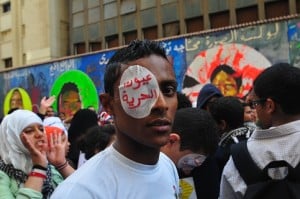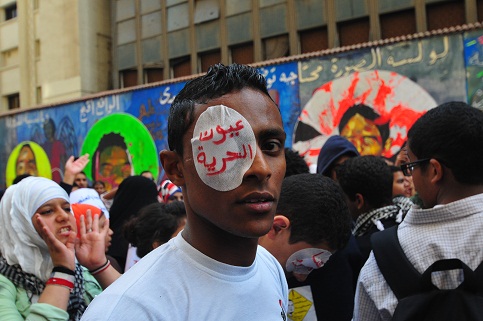
Political movements gathered on Monday to commemorate the first anniversary of the Mohamed Mahmoud Street clashes.
“This anniversary reveals the difference between those who only cared about maintaining their revolution and those whose sole concern was holding parliamentary elections,” Sally Toma, doctor and prominent revolutionary figure, said at a conference held at the press syndicate in memory of the clashes.
Mohamed Fattouh, doctor at the Community of Tahrir Doctors, gave his testimony of the clashes. He witnessed the use of live ammunition, birdshot (fired mostly at protesters’ upper bodies) and tear gas. Fattouh added that when the tear-gas used was analyzed, it was found to include a small percentage of nerve gas, which was, “though not lethal, dangerous.”
“The tear gas canisters we collected were entirely blank,” Fattouh recalled, “they didn’t have anything written on them; neither the components of the gas, nor the country of origin, nor even the expiry date.”
Fattouh stated that the doctors present within the makeshift hospitals at Tahrir Square that day were therefore unable to treat the protesters affected by the tear gas.
He also reminded those present at the conference that the two makeshift hospitals treating the Mohamed Mahmoud protesters were repeatedly targeted by the police.
“We still have the hand-written documents reporting the doctors’ activities at the makeshift hospitals,” Fattouh said,” they reveal that 45 people were killed during the clashes, 4200 were injured, including 150 eye-injuries.”
Despite the abundance of video evidence of police officers shooting at protesters, Fattouh said, none of those responsible were punished throughout the year.
“How will we raise our children and teach them the consequences of their mistakes as long as those responsible remain unpunished?” Fattouh said.
Among the other issues visited during the press conference was what the speakers referred to as “safe exit” for the Supreme Council of Armed Forces’ (SCAF) members.
“President Mohamed Morsy assumed power to implement Ahmed Shafiq’s agenda,” Toma said, in reference to Shafiq’s affiliation with the former regime and the SCAF.
Meanwhile in Mohamed Mahmoud Street, hundreds of protesters gathered from noon. Marches simultaneously arrived in the Downtown Street, which was far from full; many planning to come later in the day, when they finish work. Nevertheless the protesters entirely blocked access to Mohamed Mahmoud Street from Tahrir square; no cars passed through the street.
The protesters were loud, despite the relatively small number at that point in the day. “Down with the rule of the Supreme Guide (of the Muslim brotherhood),” they chanted.
Fresh graffiti was being added to the now famous murals. Ahmed Naguib, one of the graffiti artists who have been decorating the street for about a year, took part in the deadly clashes last year.
Naguib, like many others is not optimistic about response from officials. “Nothing will change. The rights of the dead, we have to take with our own hands. The judiciary will not get us anything. We have been at this for a year and nothing has happened. And the killer is known but nothing has happened,” Naguib said.
“I can smell the smell of Mohamed Mahmoud last year… .The smell of blood and the smell of burning wood,” Naguib said.
“We don’t get scared of clashes anymore,” he said. But he is worried that more people would die. He is willing to join a sit-in, if one is started.
Minor clashes erupted at around 6pm on nearby Madrasit Al-Howeiati Street, but the Mohamed Mahmoud itself remained largely calm.
“I’m here to tell the Ministry of Interior that the blood of our martyrs will prevent your sleep,” the mother of one victim, Ahmed Soroor, said. Soroor was run over by a Central Security vehicle while protesting in front of cabinet on 26 November; the accident left him dead. “I only ask of the new Minister of Interior to hand over whoever was driving this car.”
Soroor’s mother wasn’t the only parent seeking justice for her son a year following his death. The mother and aunt of Shehab Al-Sayed also participated in Monday’s protest, holding a big photo of Al-Sayed, who was shot dead in the chest on 21 November while taking part in the Mohamed Mahmoud protests.
“All we want is punishment for those responsible for his death,” the mother said, “we don’t seek the monetary compensation the government is so abundantly distributing. Where was that money when my son was alive? Are they pricing the dead and the injured now with their compensation?”
Al-Sayed’s mother had filed a lawsuit against the former head of SCAF Field Marshal Hussein Tantawi alongside the former Interior Minister Mansour Al-Eissawy. Nobody was punished for her son’s death.
“Don’t they hear us? How do they sleep at night?” she questioned, “I haven’t been sleeping for a year!”
Hamdy Mohamed, who introduced himself as one of the “revolution’s injured,” is originally from Alexandria but was there in the Mohamed Mahmoud clashes. He was shot during the clashes in his left leg. In the Cabinet protest clashes in December, 2011, he was shot with birdshot and, “a thug burned me with acid and I gave him and the weapon he had to the police, but unfortunately he was released within two months,” he said.
“We haven’t achieved anything. The dead didn’t, the injured didn’t and the living people didn’t. We are still hunger, oppression, injustice and slavery. Our revolution wasn’t for this, our revolution was for freedom, dignity and justice…. The people died for nothing…” he said.
“We want what we demanded to be achieved. I will keep asking for this until I die and if other people die, there will be a new generation asking for this,” he said.
Dia’ Ternawly, had the Palestinian keffiyeh around his shoulders, like many others on the street, as he led a small crowd into chants. “We removed the National Democratic party (NDP) to replace it with the Freedom and Justice party (FJP),” Ternawly, a Socialist Popular Alliance party (SPAP) member, said.
Ternawly was present during the Mohamed Mahmoud clashes. “We’re here to resume our revolution and we shall not leave.”
Gasser Abdel-Kader, was holding up a poster with the pictures and information about the 8 April Officers. The 8 April Officers are a group of 29 military officers who were arrested after participating in protests in support of the revolution. While they are collectively referred to as the 8 April Officers, not all of them took part in protests on 8 April, only 22 of them did. The rest were arrested later, after joining protests in May and November, 2011. Most of them were released but five remain behind bars and several marches, protests, and campaigns to advocate for their release have been held. A hunger strike was even started by a group of activists in Dakahliya last month for their benefit.
“They were given orders to slay the civilians in protests, but they refused the order …” Abdel-Kader said. Abdel-Kader was at the square because his brother, Ala’a Abdel-Hady died during the Cabinet clashes. “The Cabinet clashes and Mohamed Mahmoud are the same thing. The people who died in both events are all my brothers and sisters,” he said.
“If we don’t get their rights, we will start a sit-in until we get their rights,” he added.
